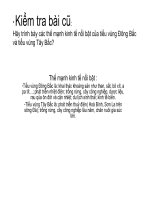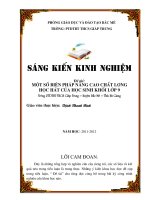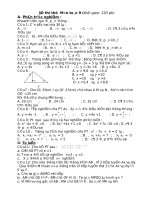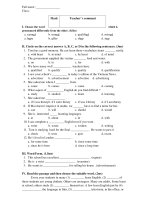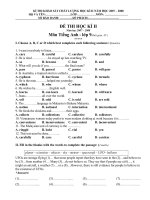lop 9 thcssssssssssssssssssss
Bạn đang xem bản rút gọn của tài liệu. Xem và tải ngay bản đầy đủ của tài liệu tại đây (57.42 KB, 2 trang )
Nguyen Cong Tru School
Week: 29
Period: 58
Lesson plan 9
Unit 9: NATURAL DISASTERS
Lesson 4: Read
Writing's date: 17/03/2018
Teaching's date:
A. Aims: Reading a text about natural disasters.
B. Objectives: By the end of the lesson, Ss will be able to get general background information on some common natural disasters.
C. Language contents:
- Vocabulary:
- Pacific Rim (n) [p]
- shift = movement [p]
- a tidal wave (n) = tsunami [p]
- hurricane (n) cyclone = typhoon [p]
- collapse (v) [p]
- erupt(v) – eruption( n) [p]
- abrupt (v) = suddenly [exp.]
- funnel-shaped (adj) [p]
- tonado (n) [p]
- suck-up (v) [p]
- Grammar: relative clause
D. Skill: Reading - Listening - Speaking
D. Techniques: guessing game, GW, PW, completing, T or F, Q-A.
E. Teaching aids: pictures, sub-board, cassette, power point.
F. Procedures:
STAGES/
TIMING/CLASS
ROOM
MANAGMENT
Nguyen
Cong Tru
I. Warm up:
7'
T-Ss/L
TEACHER'S ACTIVITIES
School
-Greeting!
1. What is the name of unit 9?
2. Can you name some natural disaster you know?
* Matching:
Give 4 pictures of natural disasters that Ss will guess in the lesson.
earthquake, volcano, typhoon, floods
- These are called “natural disasters”
II. Pre-reading: →These are some common natural disasters we often frequent.
10'
In order to understand more about them, come on our lesson please.
1. Vocabulary – Pre-teach:
T-Ss/R
- Pacific Rim (n) [p]
- a tidal wave (n) = tsunami [p]
- collapse (v) [p]
- abrupt (v) = suddenly [exp.]
- tonado (n) [p]
- shift = movement [p]
- hurricane (n) cyclone = typhoon [p]
- erupt(v) – eruption( n) [p]
- funnel-shaped (adj) [p]
- suck-up (v) [p]
* Checking vocabulary:
- T asks Ss to match the English words with their meanings.
III. While→ Setting the scene: “We are going to read a passage about five
reading:
disasters that mentioned earlier. Read and do the comprehension tasks
20'
assigned.
2. True or False statements:
→ Sets a scene: There are six statements about the information of
S-S/R
some natural disasters. All of you have to read them then have a guess
which sentence is true and which one is false.
- T gives Ss read the text (on page 78) once in silence, then read it
aloud and check their predictions.
- T tells them to PW, read the passage and decide whether the
statements are true or false. Correct the false ones.
- T calls one some Ss to explain their answers in the front class.
T-S/S,L
- T listens and give feedback.
STUDENTS' ACTIVITIES
Lesson plan 9
- GW
- Answer: 1. Natural disaster
2. Snowstorm, earthquake, volcano, typhoon
- Match the names of the disasters to its correct
pictures.
*Answer keys:
a. Earthquakes – Picture 1; b. Volcano – Picture 2
c. Floods – Picture 3; d. Typhoon – Picture 4
- Listen and repeat in chorus and individually.
- Guess its meanings and give examples.
- Copy down notebooks.
- Do the task.
* Suggestion: 1.d; 2.e; 3.f; 4.b; 5.c; 6.a
- Listen carefully and do the exercise “ True or
False “
- Compare their answer with a friend and
underline the information in the passage for their
answers.
- Report in the front class.
*Suggestion: 1. T
2. T
3. F (The tidal wave traveled from Alaska to
California)
4. T
5. F (The eruption of Mount Pinatubo is the
